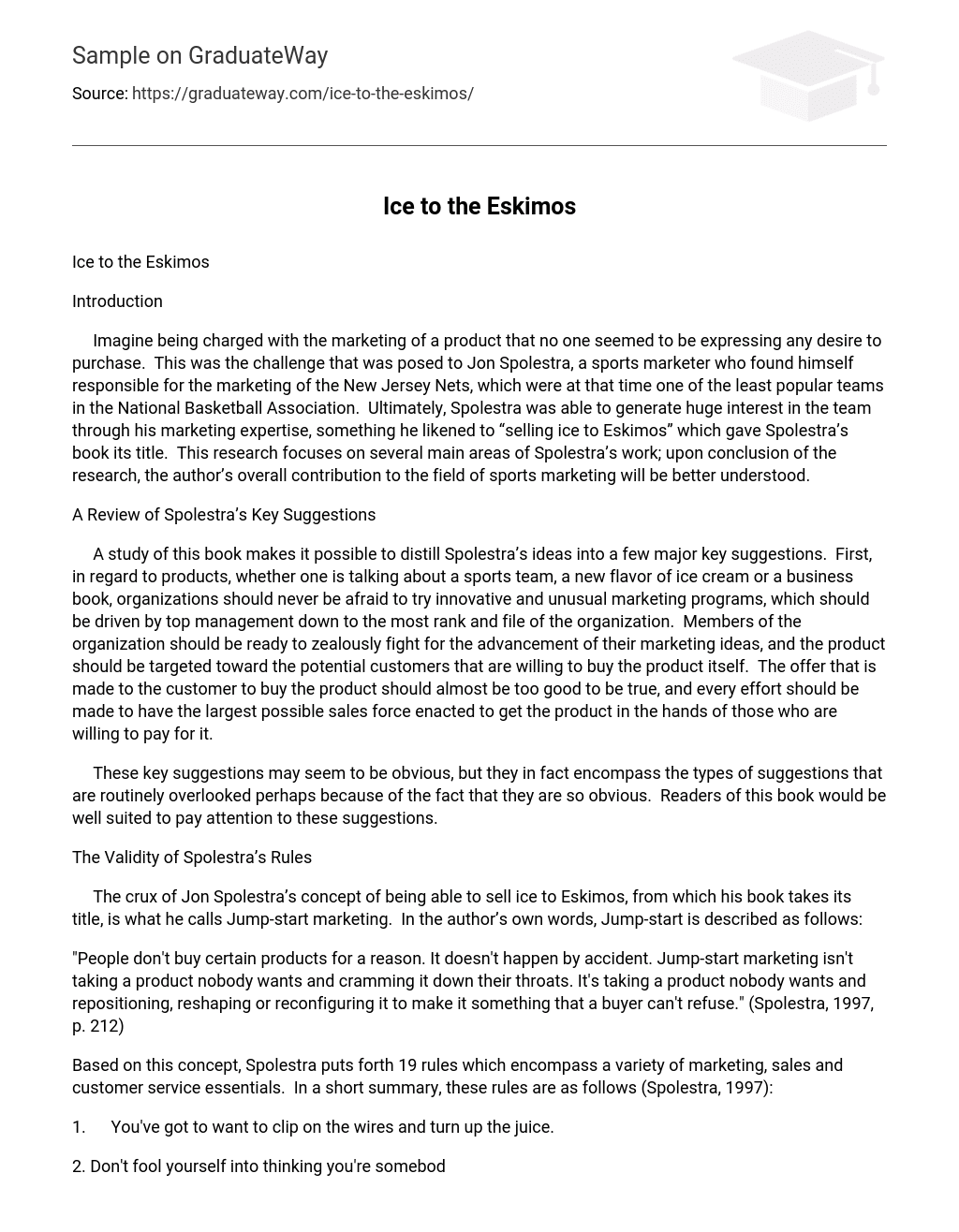Introduction
Imagine being charged with the marketing of a product that no one seemed to be expressing any desire to purchase. This was the challenge that was posed to Jon Spolestra, a sports marketer who found himself responsible for the marketing of the New Jersey Nets, which were at that time one of the least popular teams in the National Basketball Association. Ultimately, Spolestra was able to generate huge interest in the team through his marketing expertise, something he likened to “selling ice to Eskimos” which gave Spolestra’s book its title. This research focuses on several main areas of Spolestra’s work; upon conclusion of the research, the author’s overall contribution to the field of sports marketing will be better understood.
A Review of Spolestra’s Key Suggestions
A study of this book makes it possible to distill Spolestra’s ideas into a few major key suggestions. First, in regard to products, whether one is talking about a sports team, a new flavor of ice cream or a business book, organizations should never be afraid to try innovative and unusual marketing programs, which should be driven by top management down to the most rank and file of the organization. Members of the organization should be ready to zealously fight for the advancement of their marketing ideas, and the product should be targeted toward the potential customers that are willing to buy the product itself. The offer that is made to the customer to buy the product should almost be too good to be true, and every effort should be made to have the largest possible sales force enacted to get the product in the hands of those who are willing to pay for it.
These key suggestions may seem to be obvious, but they in fact encompass the types of suggestions that are routinely overlooked perhaps because of the fact that they are so obvious. Readers of this book would be well suited to pay attention to these suggestions.
The Validity of Spolestra’s Rules
The crux of Jon Spolestra’s concept of being able to sell ice to Eskimos, from which his book takes its title, is what he calls Jump-start marketing. In the author’s own words, Jump-start is described as follows:
“People don’t buy certain products for a reason. It doesn’t happen by accident. Jump-start marketing isn’t taking a product nobody wants and cramming it down their throats. It’s taking a product nobody wants and repositioning, reshaping or reconfiguring it to make it something that a buyer can’t refuse.” (Spolestra, 1997, p. 212)
Based on this concept, Spolestra puts forth 19 rules which encompass a variety of marketing, sales and customer service essentials. In a short summary, these rules are as follows (Spolestra, 1997):
1. You’ve got to want to clip on the wires and turn up the juice.
2. Don’t fool yourself into thinking you’re somebody else – accept the realistic limitations of your core product or service, and build from there.
3. Increase the frequency of purchases by your customers.
4. Get the name and address of the end user of your product.
5. A focus on jump-start marketing must come from the top.
6. Create big change with little experiments.
7. Don’t wait for a new product to bail you out – use innovative marketing now.
8. To get your ideas approved by the boss, prepare as if you were defending yourself in front of the Supreme Court.
9. Only sell a product that the customer wants to buy.
10. Get the feel for jump-start marketing outside the ivory tower.
11. Only target people who are interested in your product.
12. Don’t let research make the decision for you.
13. Make your client a bona fide, real-life hero.
14. Run interference for your budding superstars.
15. Make it too good of a deal on purpose.
16. Feel free to butt into other departments.
17. Differentiate between big and little customers.
18. When the going gets rough, increase expenses that are not fixed, like salespeople.
19. Jumping higher than you think you can is possible with jump-start marketing (Spolestra, 1997).
These rules are in fact quite valid; to use a sports analogy, they are comparable to drilling in the basic skills of a sport so that one can excel on the higher levels of the game. Spolestra is doing the same, ironically in the marketing of a sports team- by focusing on the fundamentals of marketing, sales and customer service, Spolestra maintains that excellence is realistic to attain at the highest levels.
The Wisdom of Spolestra’s Advice to Would-be Sports Marketing Managers
The wisdom of what Spolestra presents in his advice lies in the fact that he is able to take a selection of tried and true concepts and techniques and use them to retool undesirable products into those that people want and will buy. Therefore, the wisdom of his advice is proven in its effectiveness.
Conclusion: An Assessment of Spolestra’s Contribution to Sports Marketing Literature
For Jon Spolestra, the proof of the power of his Jump-start marketing concepts can be found in the impressive results that he achieved first for the NJ Nets basketball team, and later for countless other organizations and millions of readers of his book. In this regard, in conclusion, it is accurate to say that Spolestra has made a significant contribution to sports marketing literature.
Works Cited
Spolestra, Jon (1997). Ice to the Eskimos-How to Sell a Product Nobody Wants. New York: Harper Business Books





